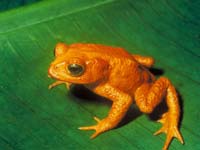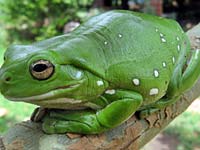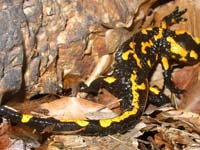
![]() Miners used to take canaries into unfamiliar shafts to act as early warning systems for the presence of poisons. Today, climate scientists have their own canaries - amphibians. Amphibians - the frogs, toads and salamanders - are particularly susceptible to environmental changes because of their fondness for water, and their porous absorbent skins. They are usually the first to feel the impact of environmental changes.
Miners used to take canaries into unfamiliar shafts to act as early warning systems for the presence of poisons. Today, climate scientists have their own canaries - amphibians. Amphibians - the frogs, toads and salamanders - are particularly susceptible to environmental changes because of their fondness for water, and their porous absorbent skins. They are usually the first to feel the impact of environmental changes.
 And feel it they have. They are one of the most threatened groups of animals and one in three species currently faces extinction. The beautiful golden toad (right) was one of the first casualties and disappeared for good in 1989. Even though they are less glamorous than tigers, pandas or polar bears, amphibians are a top priority for conservationists.
And feel it they have. They are one of the most threatened groups of animals and one in three species currently faces extinction. The beautiful golden toad (right) was one of the first casualties and disappeared for good in 1989. Even though they are less glamorous than tigers, pandas or polar bears, amphibians are a top priority for conservationists.
The usual factors - introduced predators and vanishing habitats - are partially to blame, but many populations have plummeted in parts of the world untouched by pesky humans. More recently, a large number of these deaths have been pinned on a fatal fungal disease called chytridiomycosis. Hapless individuals become infected when they swim in water used by diseased peers, and fungal spores attach to their skins. The disease had decimated amphibians across the Americans.
But it's not the only killer - climate change can join their list of enemies. In Costa Rica, warmer and wetter days have led to a loss of rainforest leaf litter that has sent amphibian and reptile populations crashing. The extent of the damage may be even worse than we think. We have very little long-term data on the population sizes of many amphibian species, particularly in the tropics, where the greatest diversity exists. One of the few sites to buck the trend of ignorance is La Selva Biological Station in Costa Rica, which has been monitoring amphibian populations since the 1950s.
 Steven Whitfield and colleagues from Florida International University used the La Selva data to analyse the populations of a species living among the leaf litter that covers the local rainforest floor. The team ran their census of about 30 species of amphibians, as well as many reptiles (lizards and snakes).
Steven Whitfield and colleagues from Florida International University used the La Selva data to analyse the populations of a species living among the leaf litter that covers the local rainforest floor. The team ran their census of about 30 species of amphibians, as well as many reptiles (lizards and snakes).
To their astonishment, the populations of these species had plummeted by 75% in 35 years. This massive decline is worrying for many reasons, the least of which is that La Selva sits within a protected area. Habitat destruction is non-existent here, so something else must be happening.
Nor is chytridiomycosis to blame. The fungus doesn't tolerate high temperatures and only grows in temperate regions or mountainous ones. La Selva is neither. The killer fungus marks its presence with rapid falls in amphibian numbers within months, but these declines took place over decades. And most tellingly of all, the reptiles suffered population losses as great as those of the amphibians. With their dry, scaly skins, reptiles lack the amphibian vulnerability to chemicals and chytridiomycosis. Something else is afoot.
 Whitfield believes that climate change is the answer. Over the past 35 years, La Selva has experienced wetter and warmer days. Temperatures have gone up by one degree Celsius, which slows the growth of local trees, and reduces the volume of leaves that they shed. The number of dry days has halved, and with more rainfall, the leaves that do fall decay faster.
Whitfield believes that climate change is the answer. Over the past 35 years, La Selva has experienced wetter and warmer days. Temperatures have gone up by one degree Celsius, which slows the growth of local trees, and reduces the volume of leaves that they shed. The number of dry days has halved, and with more rainfall, the leaves that do fall decay faster.
So these combined climate changes have conspired to reduce the levels of leaf litter in the forest, robbing amphibians and reptiles alike of their homes. Even in this protected area, habitat destruction is going on right under our feet.
The climate change idea explains another odd finding. Whitfield saw that amphibian and reptile numbers had not declined in nearby abandoned cacao plantations. That's because cacao trees shed their leaves throughout the year and provide a continual supply of new leaf litter.
The picture for the world's amphibians seemed bleak enough, but it seems that we have been ignoring a larger simmering danger in the face of the immediate threat of chytridiomycosis. It is telling that all but one of the disappearing species in this study are listed as 'least concern' by the World Conservation Union (IUCN). Whitfield's study should be a call to action for conservationists.
Reference: Whitfield, Bell, Phillippi, Sasa, Bolanos, Chaves, Savage & Donnelly. 2007. Amphibian and reptile declines over 35 years at La Selva, Costa Rica. PNAS doi.0611256104.
Related stuff:
- Common pesticide is good news for parasites, bad news for frogs
- Climate change squeezes jumbo squid out of oxygen
- Lions killed by perfect storm of changing climate, virus and parasites
- Rising carbon dioxide levels weaken plant defences against hungry insects
- Climate change knocked mammoths down, humans finished them off


This is pretty horrifying, depressing stuff, really. But it's great to be able to know about it.
Now we just have to figure out how much we need to cut back greenhouse gas emissions in order to stop the planet getting warmer.
Or should we be planning to produce more greenhouse gasses to help warm the place up after the ice age hits?